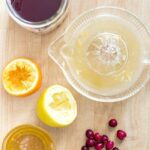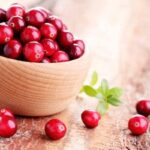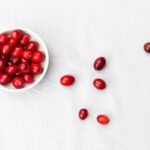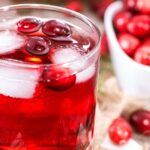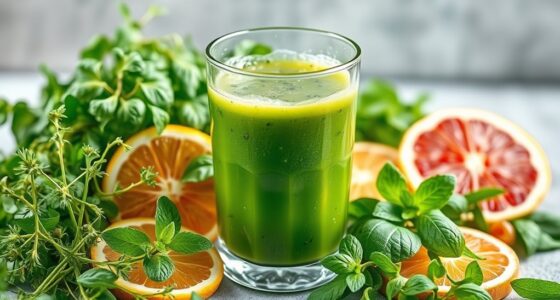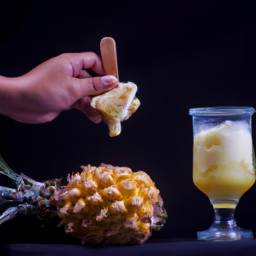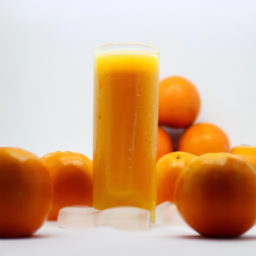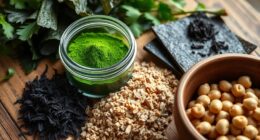As someone who loves drinking cranberry juice, I have often faced the issue of its high acidity. This sharpness can be overwhelming at times, leading to discomfort in my stomach. However, I have slowly learned a few methods to decrease the acidity in cranberry juice, making it a more enjoyable drink.
In this article, I will share these tips with you, so you too can enjoy the many health benefits of cranberry juice without the unpleasant taste.
Cranberry juice is widely known for its ability to prevent and treat urinary tract infections, due to its high levels of antioxidants and anti-inflammatory properties. However, despite its many health benefits, the high acidity of cranberry juice can make it difficult for some people to drink.
The acidic taste can be especially troublesome for those with sensitive stomachs, as it can cause heartburn, acid reflux, and other digestive issues. Fortunately, there are several ways to make cranberry juice less acidic, and in this article, we will explore some of the most effective methods.
Key Takeaways
- Dilute cranberry juice with water or other neutral liquids
- Add sweeteners like honey, maple syrup, or stevia to reduce acidity
- Use a blender or juicer to smooth out cranberries
- Add alternative ingredients like apples or pears to reduce acidity and increase flavor
Why Cranberry Juice is Acidic
Did you know that one of the reasons why cranberry juice can be so acidic is because of its high levels of citric acid? Citric acid is a weak organic acid that is naturally found in many fruits, including cranberries. It is responsible for giving cranberry juice its tart, acidic taste.
However, for people who suffer from urinary tract infections (UTIs), the high acidity of cranberry juice can exacerbate their symptoms, causing discomfort and pain during urination.
Despite its acidic nature, cranberry juice is also packed with essential vitamins and minerals that are beneficial for overall health. It is rich in vitamin C, which supports a healthy immune system and helps to fight off infections. Additionally, cranberry juice contains antioxidants that protect the body against free radical damage and inflammation.
However, for those who find the acidity of cranberry juice too much to handle, there are ways to make it less acidic. One of the easiest ways is to dilute it with water or another neutral liquid.
Dilute with Water or Another Neutral Liquid
When it comes to reducing the acidity of cranberry juice, diluting it with water or another neutral liquid is a simple and effective solution. Personally, I prefer using water as it’s easily accessible and doesn’t affect the taste too much.
But if you want to experiment with other neutral liquids, try adding apple juice or coconut water for a slightly sweeter taste. The key is to find the perfect ratio of cranberry juice to the diluting liquid that suits your taste buds.
How Much Water to Add
Congratulations, you’ve decided to dilute your cranberry juice with water! Now, let’s get to the important question: how much H2O should you add to make it less acidic? Measuring accurately is key to achieving the desired taste. I recommend adding 1 part water for every 3 parts cranberry juice. This will make the juice less tart and more refreshing.
To make it easier for you to measure, here’s a simple table that shows the amount of water to add for different amounts of cranberry juice:
| Cranberry Juice | Water |
|---|---|
| 1 cup | 1/3 cup |
| 2 cups | 2/3 cup |
| 3 cups | 1 cup |
Using other liquids, such as apple juice or grape juice, can also be effective in reducing the acidity of cranberry juice. These liquids have a natural sweetness that complements the tartness of cranberry juice. However, be mindful of the added sugar in these other liquids, as it can increase the overall sugar content of your drink.
Other Neutral Liquids to Try
Looking to experiment with the taste of your cranberry juice? Try adding alternative options like apple or grape juice. These neutral liquids complement the tartness of cranberry and offer a delicious twist to your juice.
Depending on your taste preferences, you can adjust the amount of neutral liquid you add to your cranberry juice. Start with small amounts and gradually increase until you find the perfect balance. It’s important to note that adding other liquids will dilute the cranberry juice, so keep this in mind when measuring out the amount of juice you need.
Also, be mindful of the sugar content of the additional liquids you add. If you’re trying to reduce your sugar intake, look for unsweetened options. Once you’ve added your neutral liquid, give your cranberry juice a taste. If you find that it’s still too tart, move on to the next step and add a natural sweetener.
Add a Natural Sweetener
When trying to make cranberry juice less acidic, adding a natural sweetener can be a great option. Personally, I prefer using honey because it not only adds sweetness but also has antibacterial properties that can help with maintaining a healthy gut.
Maple syrup is another great option for those who prefer a more earthy flavor, while stevia is perfect for those who are looking for a zero-calorie sweetener. Keep in mind, when adding sweeteners, it’s important to do so in moderation to avoid overloading on sugar.
Honey
If you’re looking to make your cranberry juice less acidic, adding a touch of honey can make all the difference. Not only does honey sweeten the tartness of cranberry juice, but it also offers additional health benefits.
Here are 4 reasons why using honey as a natural sweetener for your cranberry juice is a great idea:
-
Honey is a natural source of antioxidants, which can help protect your body from damage caused by free radicals.
-
Honey has antibacterial properties that can help promote a healthy immune system.
-
Honey contains phytonutrients that can help reduce inflammation in the body.
-
Honey has a lower glycemic index than sugar, meaning it won’t cause a spike in blood sugar levels.
Now that you know the benefits of honey, it’s time to move on to another natural sweetener option – maple syrup.
Maple Syrup
So, in our previous discussion, we talked about using honey to make cranberry juice less acidic. If you’re not a fan of honey or simply want to try something different, there are other alternatives available.
One of them is maple syrup. Maple syrup is a popular natural sweetener that can be used in various ways. It contains antioxidants and minerals such as zinc, calcium, and potassium. It also has a lower glycemic index than sugar, making it a great alternative for those watching their blood sugar levels.
To use maple syrup in your cranberry juice, simply add a small amount and adjust to your desired sweetness. You can also experiment with using maple syrup in other drinks, such as coffee or tea, to add a touch of sweetness.
Moving on to other alternatives, another option to consider is stevia.
Stevia
Interestingly, using stevia as a natural sweetener can bring a hint of sweetness to your favorite drinks without adding any calories. This makes it an excellent alternative to sugar or other high-calorie sweeteners when trying to make cranberry juice less acidic.
Stevia is a plant-based sugar substitute that is 200-300 times sweeter than regular sugar, so you only need a small amount to sweeten your juice. Compared to other sweeteners, stevia has a low glycemic index, which means it doesn’t cause a spike in blood sugar levels. It also has no carbohydrates, making it a suitable option for those following a low-carb or diabetic diet.
While other sweeteners like honey or maple syrup may add flavor to your cranberry juice, they also add calories. Stevia, on the other hand, allows you to enjoy a sweet treat without worrying about the added calories.
When it comes to making cranberry juice less acidic, using stevia is a great option. However, to get the most out of your cranberries, you may want to consider using a blender or juicer.
Use a Blender or Juicer
To make cranberry juice less acidic, I recommend using a blender or juicer. Blending techniques are a great way to break down the cranberries until they are smooth, which ultimately reduces their acidity. By doing this, the juice becomes less tart and more palatable.
If you don’t have a juicer, you can blend the cranberries with water and strain the mixture through a cheesecloth to remove any pulp or seeds. You can also try finding alternative ingredients to mix with the cranberries, such as apples or pears, to help balance out the acidity.
Once the juice is prepared, it’s essential to remember to drink it cold or over ice, as this can also help to mask any residual sourness.
Using a blender or juicer is an effective way to make cranberry juice less acidic. By blending the berries until they are smooth and straining the mixture, you can create a delicious and less tart juice. Don’t forget to add alternative ingredients or serve the juice cold or over ice to balance out the acidity.
Drink Cold or over Ice
I’ve found that one effective way to make cranberry juice less acidic is by drinking it cold or over ice. Temperature matters when it comes to the taste and acidity of a beverage. Colder temperatures can help to mask the tartness of cranberry juice. Additionally, ice can act as a neutralizer, further reducing the acidic taste.
Why Temperature Matters
While it may seem counterintuitive, heating up your cranberry juice can actually help to reduce its acidity. This is because the heat breaks down the chemical structure of the juice, making it less acidic. In fact, many professional chefs and bartenders use this technique to control acidity in fruit juices.
To make your cranberry juice less acidic, you can heat it up in a saucepan over low heat until it reaches a temperature of about 120°F. Be careful not to overheat the juice as this can cause it to lose its flavor and nutritional value. Once heated, you can add a few ingredients to balance the flavor and further reduce the acidity. Consider adding honey, sugar, or cinnamon to create a warm and comforting drink that is perfect for colder months.
By warming up your cranberry juice, you can reduce its acidity and create a more balanced flavor. However, if you prefer a cooler drink, there are other ways to control the acidity. One popular method is to drink the juice cold or over ice, which we’ll discuss in the next section.
Ice as a Neutralizer
Now that we know why temperature matters when it comes to reducing the acidity of cranberry juice, let’s move on to another technique.
Have you ever tried using ice as a neutralizer? It might sound strange, but it can actually work wonders in reducing the tartness of cranberry juice.
By adding a few ice cubes to your glass of cranberry juice, the cold temperature can help to mellow out the acidity and create a smoother taste. You can also experiment with different sweeteners, such as honey or agave, to balance out the flavor and make it more palatable. However, be careful not to overdo it with the sweeteners, as this can add unnecessary calories and negate the health benefits of cranberry juice.
As we continue our journey towards making cranberry juice less acidic, the next step is to choose low-acid varieties.
Choose Low-Acid Varieties
I want to share some information about choosing low-acid varieties of cranberry juice.
Did you know that there are different types of cranberries that vary in acidity levels? By choosing a low-acid variety, you can reduce the acidity in your cranberry juice and make it more enjoyable to drink.
You can find low-acid cranberry juice at specialty health food stores or online retailers.
Different Types of Cranberries
You’ll love learning about the different types of cranberries that can be used to make your cranberry juice less acidic.
There are two main types of cranberries: the American cranberry (Vaccinium macrocarpon) and the European cranberry (Vaccinium oxycoccos). The American cranberry is the more commonly cultivated variety and is the one typically used in commercial cranberry juice production. The European cranberry, on the other hand, is smaller, tarter, and less commonly cultivated.
Despite their differences in taste, both types of cranberries offer numerous nutritional benefits. They are low in calories and high in antioxidants, vitamins, and minerals. Cranberries are particularly rich in vitamin C and fiber, and have been shown to have anti-inflammatory and antibacterial properties.
With these benefits in mind, it’s easy to see why incorporating cranberries into your diet can be a smart choice.
Now, let’s explore where to buy low-acid cranberry juice.
Where to Buy Low-Acid Cranberry Juice
If you’re looking for a way to enjoy the nutritional benefits of cranberries without the high acidity, finding low-acid cranberry juice can be an excellent option. Low-acid cranberry juice is available in most health food stores and online retailers. Here are some popular brands and their respective acid levels:
| Brand | Acid Level |
|---|---|
| Ocean Spray | 2.3-2.5 |
| Lakewood Organic | 2.5-2.8 |
| Knudsen Just Cranberry | 2.8-3.3 |
In addition to being easier on the stomach, low-acid diets have been linked to various health benefits. These include improved digestion, reduced inflammation, and lower risk of certain diseases such as osteoporosis and kidney stones. However, if low-acid cranberry juice is not readily available or doesn’t suit your taste, there are alternatives to consider such as mixing with other juices or beverages.
By mixing low-acid cranberry juice with other juices or beverages, you can create a delicious and nutritious drink that suits your taste preferences. In the next section, we’ll explore some of the best juices and drinks to mix with cranberry juice for a flavorful and healthful beverage.
Mix with Other Juices or Beverages
Mixing cranberry juice with other juices or beverages can make it less acidic and more enjoyable to drink. Here are some mixing options and flavor combinations to try:
-
Mix with orange juice: Orange juice is a great option to mix with cranberry juice because it neutralizes the acidity and adds a sweet flavor. Mix equal parts of cranberry and orange juice to create a refreshing drink that’s perfect for breakfast or as a mid-day snack.
-
Add honey: If you prefer to drink pure cranberry juice but find it too acidic, try adding a teaspoon of honey to a glass of cranberry juice. Honey is a natural sweetener that can help balance out the tartness of the cranberry juice.
-
Mix with sparkling water: For a more refreshing and bubbly drink, mix cranberry juice with sparkling water. This combination not only reduces the acidic taste but also adds a bit of effervescence to your drink.
By mixing cranberry juice with other beverages or adding a sweetener like honey, you can make it less acidic and more enjoyable to drink. However, if you prefer to take cranberry supplements instead, read on to the next section.
Take Cranberry Supplements
I’ve found that taking cranberry supplements can be an effective way to reap the benefits of this tart fruit without having to consume large amounts of cranberry juice.
Capsules and tablets are available in many health food stores and pharmacies, and they offer a convenient way to get a concentrated dose of cranberry extract.
However, it’s important to be aware of the potential benefits and risks associated with taking cranberry supplements.
Capsules and Tablets
One solution for reducing the acidity of cranberry juice is to try taking capsules or tablets instead. Capsules and tablets offer a more concentrated form of cranberry that can be easier on the stomach. Additionally, they provide a convenient way to consume cranberry without having to worry about the tart taste.
If you decide to take cranberry capsules or tablets, it’s important to be mindful of the proper dosage and potential side effects. The table below highlights some benefits and dosage recommendations for capsules, as well as potential side effects of tablets:
| Capsules | Benefits | Dosage |
|---|---|---|
| Cranberry extract capsules | May prevent urinary tract infections | 500mg twice daily |
| Cranberry powder capsules | May improve gut health | 500mg twice daily |
| Tablets | Potential Side Effects |
|---|---|
| Cranberry chewable tablets | Upset stomach |
| Cranberry effervescent tablets | High sugar content |
It’s always a good idea to consult with a healthcare professional before starting any new supplements or medications. With proper guidance, taking cranberry capsules or tablets can be a helpful way to reap the benefits of cranberry without the added acidity of the juice. Moving forward, it’s important to weigh the benefits and risks of different cranberry products to find the best option for your individual needs.
Benefits and Risks
To fully understand the benefits and risks of consuming cranberry, it’s important to consider all available information and consult with a healthcare professional. Here are some benefits and risks to keep in mind:
-
Benefits: Cranberry juice has been shown to help prevent urinary tract infections (UTIs) in some people. It’s also high in antioxidants, which can help protect against cell damage.
-
Risks: Cranberry juice can be high in sugar, which can be a problem for people with diabetes or other conditions that require them to monitor their blood sugar levels. Additionally, some people may experience stomach upset or diarrhea after consuming cranberry juice.
It’s important to weigh the benefits and risks before deciding whether or not to consume cranberry juice. If you have a history of UTIs or are looking for a natural way to prevent them, cranberry juice may be a good option for you. However, if you have concerns about sugar intake or have experienced negative side effects from consuming cranberry juice in the past, it may be best to avoid it.
In the next section, we’ll discuss how adjusting your diet can also help prevent UTIs.
Adjust Your Diet
You can reduce the acidity of your cranberry juice by changing your eating habits and incorporating low-acidic foods into your diet. Consuming foods that are low in acid can help neutralize the acid in your stomach and reduce the acidic content of cranberry juice.
Some low-acidic foods that you can incorporate into your diet include bananas, melons, oatmeal, and green vegetables, such as broccoli and spinach. Additionally, you can try reducing your intake of high-acidic foods, such as citrus fruits, tomatoes, and processed foods, which can contribute to high acidity levels in your body.
By making these dietary changes, you can make your cranberry juice less acidic, which may help reduce the risk of developing acid reflux or other digestive problems. However, it’s important to consult with a doctor if you have any concerns about your diet or health.
Consult with a Doctor
When it comes to drinking cranberry juice, it’s important to know when to seek medical advice. While cranberry juice is generally safe for most people, there are some potential side effects to be aware of.
As someone who’s experienced urinary tract infections in the past, I know that it’s important to consult with a doctor if symptoms persist or worsen after drinking cranberry juice.
When to Seek Medical Advice
If you’re experiencing persistent stomach pain or other symptoms after drinking cranberry juice, it may be time to consult a healthcare professional. While cranberry juice is generally considered safe for most people, there are certain symptoms to watch for that may indicate a problem.
These symptoms include nausea, vomiting, diarrhea, and abdominal pain. It’s also important to note the importance of regular check-ups with your doctor, especially if you have any underlying health conditions.
Some people may be more susceptible to the acidic nature of cranberry juice, and may experience more severe symptoms as a result. If you’re unsure whether or not cranberry juice is safe for you to consume, it’s always best to err on the side of caution and consult with your healthcare provider.
With that said, let’s now take a look at possible side effects of drinking cranberry juice.
Possible Side Effects of Drinking Cranberry Juice
Be aware of the potential side effects of drinking cranberry juice, as they can impact your overall health and well-being. While cranberry juice is generally safe for most people, some individuals may experience adverse reactions.
One of the most common side effects of drinking cranberry juice is stomach upset, such as nausea, diarrhea, or abdominal pain. This is due to the high acidity of cranberry juice, which can irritate the lining of the stomach and cause digestive distress.
In addition to stomach upset, drinking too much cranberry juice can also lead to increased risk of kidney stones. Cranberries contain high levels of oxalate, a substance that can bind with calcium to form kidney stones. Therefore, individuals with a history of kidney stones or calcium oxalate stones should avoid consuming large amounts of cranberry juice.
As with any food or beverage, it’s important to consume cranberry juice in moderation and be aware of your body’s response to it.
Frequently Asked Questions
How does the acidity of cranberry juice affect the body?
The acidity of cranberry juice can erode tooth enamel and lead to tooth decay. It’s important to limit consumption or use alkaline alternatives like water or milk to neutralize the acidity.
Can adding milk or cream to cranberry juice help reduce acidity?
Adding milk or cream to cranberry juice can help reduce acidity and create a smoother taste. Milk can also add beneficial nutrients and proteins to the drink. Alternative ways to reduce acidity include adding water or a sweetener.
How does the ripeness of cranberries impact the acidity of the resulting juice?
The ripeness of cranberries impacts the acidity of resulting juice. Cranberry harvesters aim for an ideal ripeness that balances sweetness and tartness. The more ripe the cranberries, the less acidic the juice will be.
Are there any potential side effects of consuming cranberry juice that is too acidic?
Consuming cranberry juice that is too acidic can cause potential risks and health concerns such as stomach upset, heartburn, and acid reflux. It’s important to consume in moderation and consider adding alkaline ingredients to balance the acidity.
How long can cranberry juice be stored before it becomes too acidic to consume?
Storing cranberry juice properly is key to maintaining its quality. Check the expiration date and refrigerate promptly. Preserving freshness extends usability, preventing spoilage. As for acidity, it varies by brand and storage conditions.
Conclusion
Overall, making cranberry juice less acidic can be a simple and effective way to enjoy this tart and flavorful beverage without any unwanted digestive issues. As someone who’s personally struggled with acid reflux and other stomach problems, I can attest to the benefits of diluting cranberry juice with water or adding a natural sweetener to balance out the acidity.
Interestingly, recent studies have also shown that drinking cranberry juice may have some surprising health benefits beyond just its delicious taste. For example, research has found that regular consumption of cranberry juice may help prevent urinary tract infections, lower blood pressure, and even improve cognitive function.
So, if you’re looking for a way to improve your health while still enjoying a refreshing drink, consider trying out some of these tips for making cranberry juice less acidic. Your taste buds (and your body) will thank you!
Ilana has been a vegan for over 10 years. She originally made the switch for health reasons, but soon found herself becoming more and more passionate about the ethical and environmental implications of a vegan lifestyle. Ilana is the author of The Graceful Kitchen, a blog all about veganism. She loves to cook up delicious and nutritious vegan meals, and share her recipes with others who are interested in leading a cruelty-free life. Ilana is also a strong advocate for using whole foods as the foundation of a healthy diet, and believes that going vegan is one of the best ways to achieve this.



